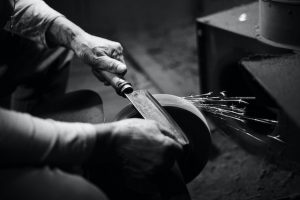Having the proper equipment in your workshop is essential if you want to increase productivity and precision. A belt grinder is a versatile machine used for many tasks, such as metalworking and knife sharpening. In this detailed tutorial, we’ll show you how to choose the best belt grinder for your Australian garage or workshop by going over all the options and explaining why you should prioritize each one.
Purpose and Usage:
Begin by understanding the primary purpose of your belt grinder. Are you planning to use it for heavy-duty metal grinding or intricate knife sharpening? Different tasks require different features, such as varying motor power and belt speed. A grinder like the 84 Engineering Belt Grinder might suit metalworking, while a more precise option is preferable for knife sharpening.
Motor Power:
 The heart of any belt grinder is its motor. The motor’s power determines the efficiency and effectiveness of the grinder. For heavy grinding tasks, a higher horsepower is recommended, whereas delicate tasks like knife sharpening might require a lower but steady power output. Ensure the grinder’s motor aligns with your intended usage.
The heart of any belt grinder is its motor. The motor’s power determines the efficiency and effectiveness of the grinder. For heavy grinding tasks, a higher horsepower is recommended, whereas delicate tasks like knife sharpening might require a lower but steady power output. Ensure the grinder’s motor aligns with your intended usage.
Belt Size and Speed:
Belt grinders come with different belt sizes and speeds. A wider belt provides more surface area for grinding, making it suitable for larger projects. The belt speed affects how much material is removed per second. Higher belt speeds are preferable for heavy material removal, while slower speeds are better for precision work like knife sharpening.
Adjustable Platen and Work Rest:
A grinder equipped with an adjustable platen and work rest offers flexibility in various tasks. An adjustable platen allows you to change the angle of the belt, enabling you to achieve different bevels while sharpening knives. A versatile work rest supports different shapes and sizes of workpieces.
Durability and Build Quality:
Considering the robust nature of workshop tasks, durability is a key aspect. Look for grinders constructed from sturdy materials that can withstand the rigors of heavy use. Stainless steel components and solid construction ensure longevity, even in demanding workshop environments.
Dust Collection:
Grinding generates a significant amount of dust and debris, which can be hazardous to your health and impact the cleanliness of your workshop. Opt for a grinder that offers efficient dust collection mechanisms. This feature not only keeps your workspace cleaner but also ensures your safety.
Ease of Use and Maintenance:
A user-friendly belt grinder saves you time and effort. Look for features such as easily adjustable settings and tool-free belt changes. Additionally, choose a grinder that is easy to clean and maintain, as regular maintenance extends the tool’s lifespan and performance.
Price and Value:
While price is a factor, it’s essential to focus on the value the belt grinder brings to your workshop. A high-quality grinder might have a higher initial cost but could save you money in the long run due to its durability and consistent performance.
In conclusion, selecting the right belt grinder for your Australian workshop requires careful consideration of your intended tasks, motor power, belt size and speed, adjustability, build quality, dust collection, ease of use and value for money. Whether you’re looking to tackle heavy-duty metal grinding or achieve precise knife sharpening, a grinder like the 84 Engineering Belt Grinder can offer the versatility and performance you need. By evaluating these factors and understanding your workshop’s unique requirements, you can make an informed decision that enhances your work quality and efficiency.
A Guide to Selecting the Perfect Belt Grinder for Your Australian Workshop,